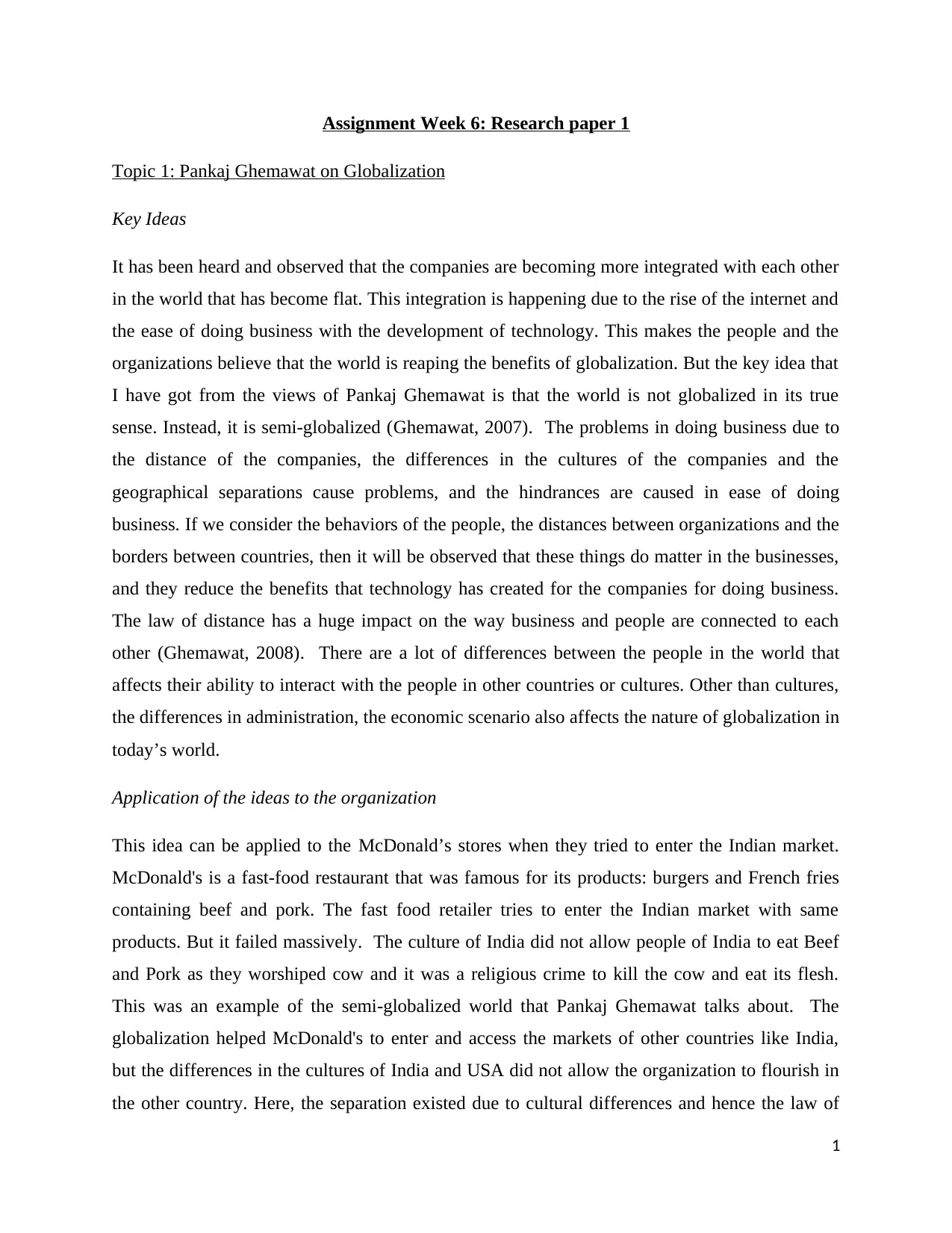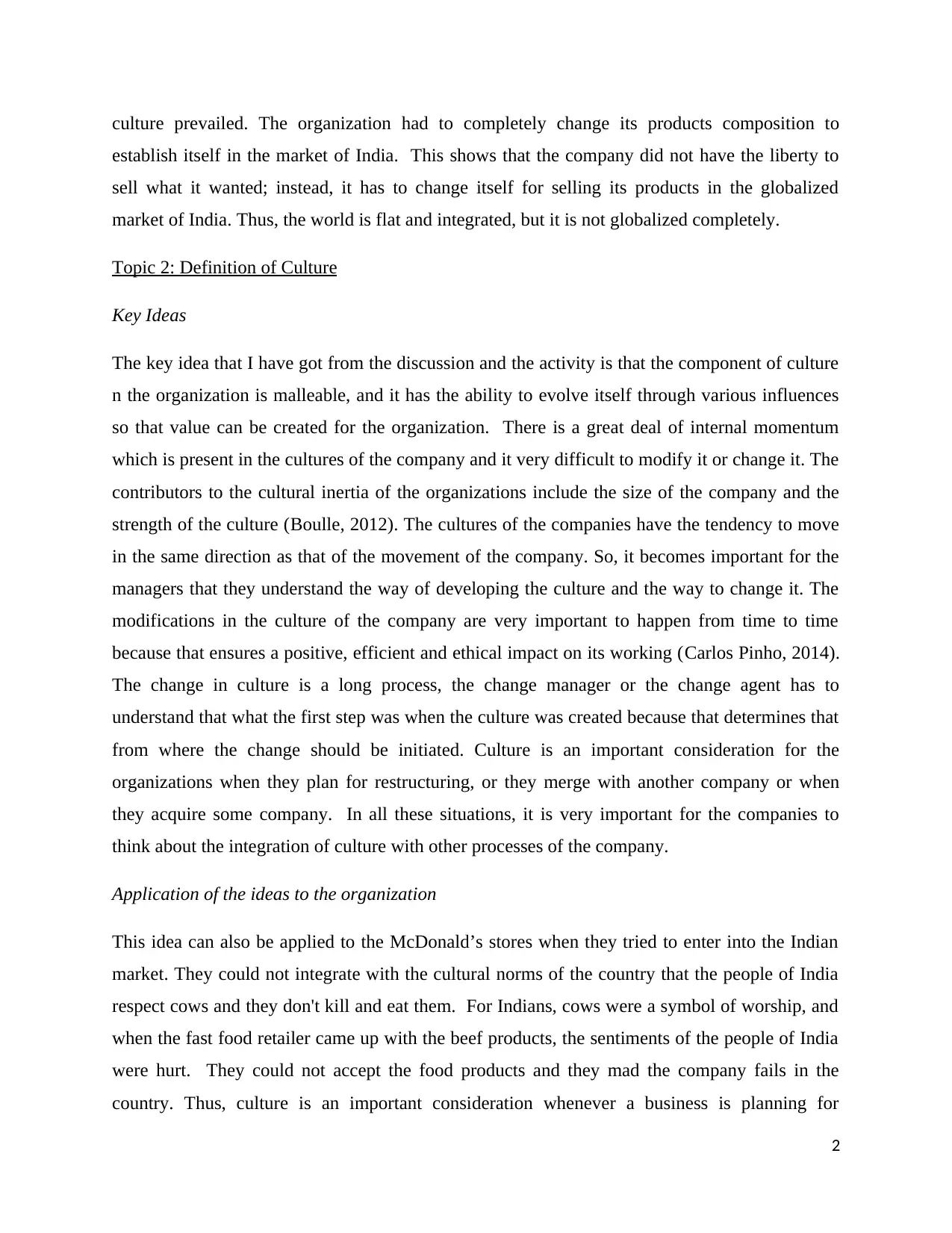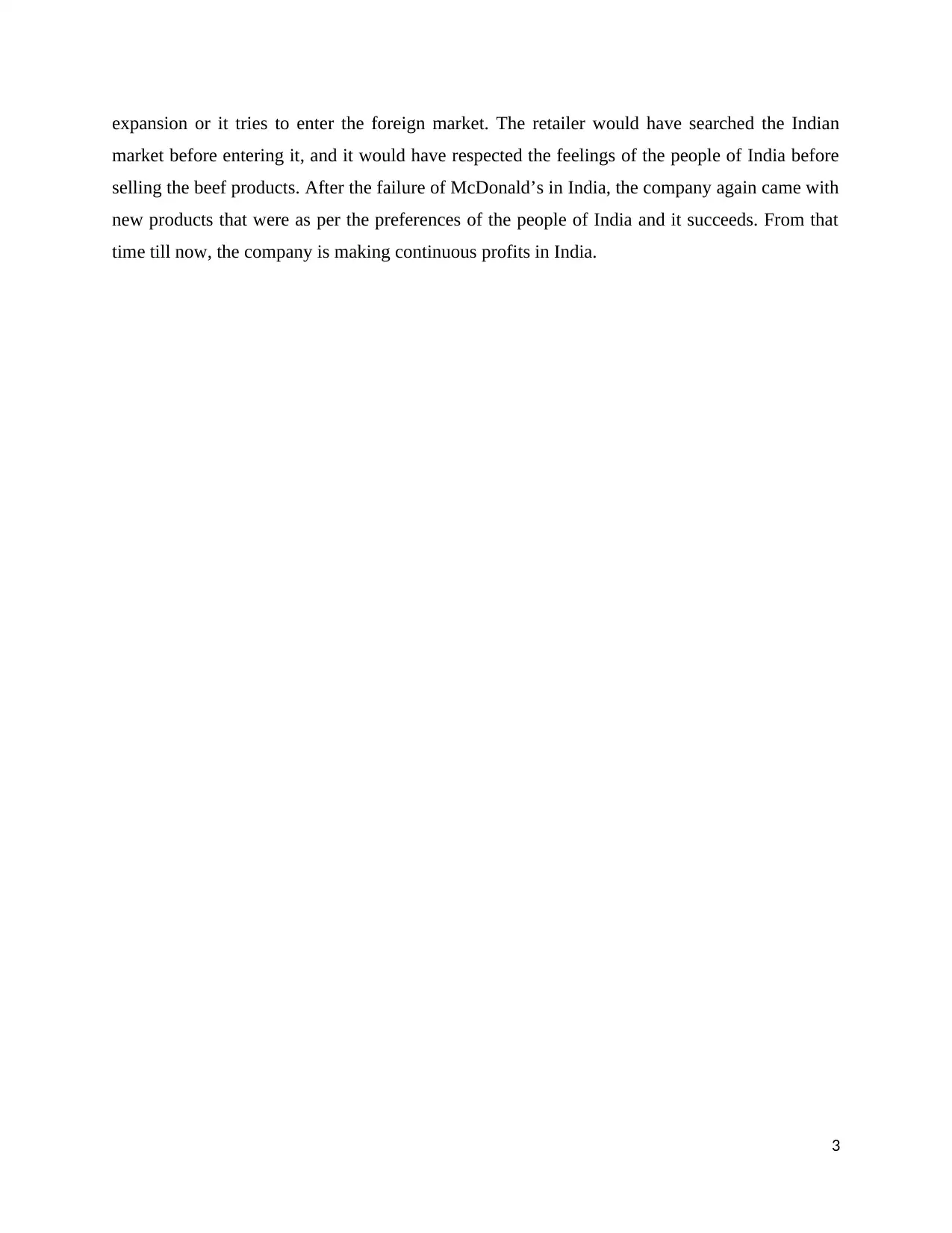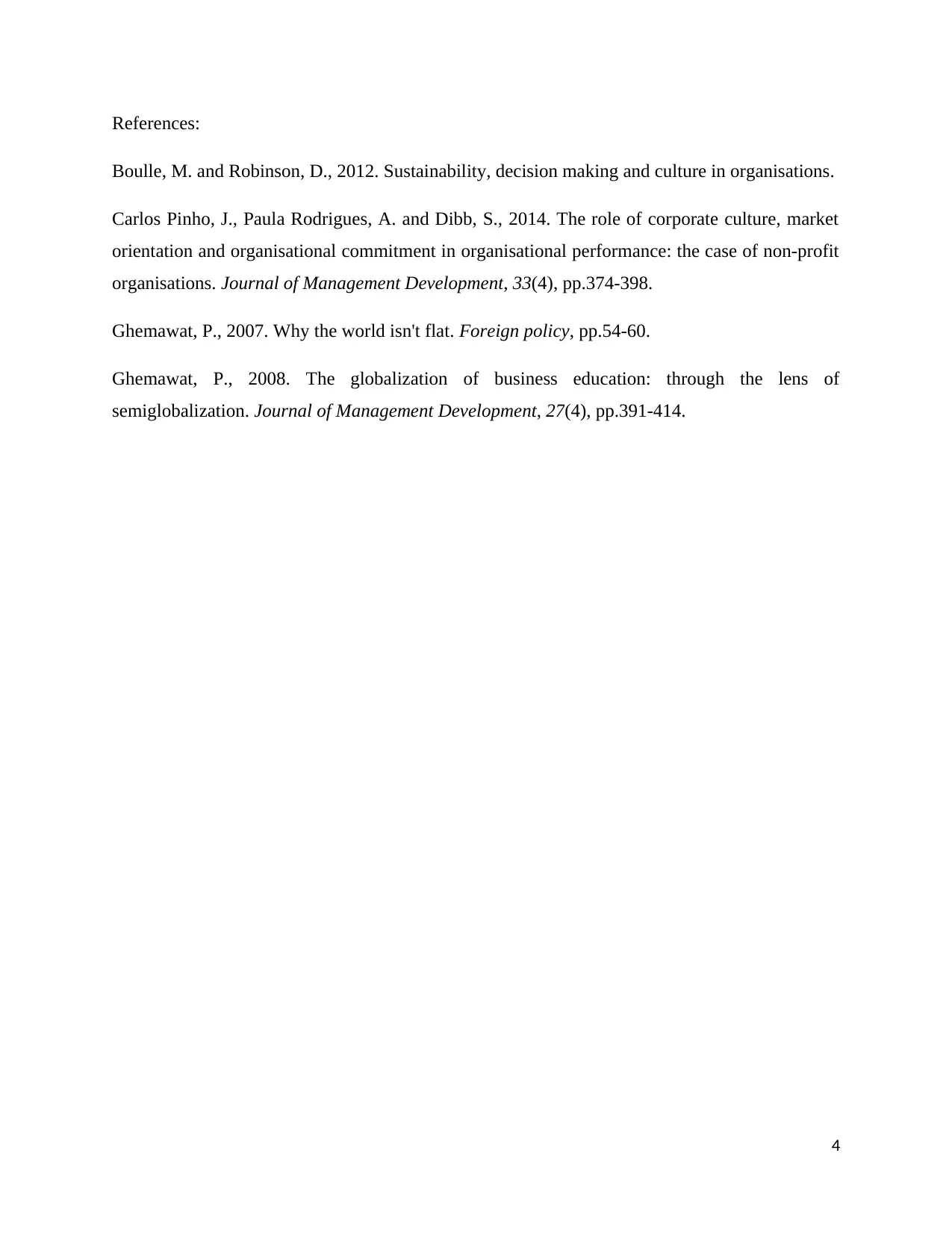Globalization, Culture, and Strategic Business Applications
VerifiedAdded on 2019/09/30
|4
|1135
|34
Report
AI Summary
This report analyzes the key ideas of Pankaj Ghemawat on globalization, arguing that the world is semi-globalized rather than fully globalized due to factors like distance, cultural differences, and geographical separations that hinder business operations. It explores how cultural differences impact business strategies, using McDonald's entry into the Indian market as a case study. The report also examines the definition of organizational culture, highlighting its malleability and the importance of adapting it to create value, and again uses the McDonald's example. The report emphasizes that cultural considerations are crucial for companies expanding internationally or entering foreign markets, and that failing to account for cultural differences can lead to business failures. It concludes by underscoring the need for businesses to understand and respect local cultures to succeed in the global market.

Assignment Week 6: Research paper 1
Topic 1: Pankaj Ghemawat on Globalization
Key Ideas
It has been heard and observed that the companies are becoming more integrated with each other
in the world that has become flat. This integration is happening due to the rise of the internet and
the ease of doing business with the development of technology. This makes the people and the
organizations believe that the world is reaping the benefits of globalization. But the key idea that
I have got from the views of Pankaj Ghemawat is that the world is not globalized in its true
sense. Instead, it is semi-globalized (Ghemawat, 2007). The problems in doing business due to
the distance of the companies, the differences in the cultures of the companies and the
geographical separations cause problems, and the hindrances are caused in ease of doing
business. If we consider the behaviors of the people, the distances between organizations and the
borders between countries, then it will be observed that these things do matter in the businesses,
and they reduce the benefits that technology has created for the companies for doing business.
The law of distance has a huge impact on the way business and people are connected to each
other (Ghemawat, 2008). There are a lot of differences between the people in the world that
affects their ability to interact with the people in other countries or cultures. Other than cultures,
the differences in administration, the economic scenario also affects the nature of globalization in
today’s world.
Application of the ideas to the organization
This idea can be applied to the McDonald’s stores when they tried to enter the Indian market.
McDonald's is a fast-food restaurant that was famous for its products: burgers and French fries
containing beef and pork. The fast food retailer tries to enter the Indian market with same
products. But it failed massively. The culture of India did not allow people of India to eat Beef
and Pork as they worshiped cow and it was a religious crime to kill the cow and eat its flesh.
This was an example of the semi-globalized world that Pankaj Ghemawat talks about. The
globalization helped McDonald's to enter and access the markets of other countries like India,
but the differences in the cultures of India and USA did not allow the organization to flourish in
the other country. Here, the separation existed due to cultural differences and hence the law of
1
Topic 1: Pankaj Ghemawat on Globalization
Key Ideas
It has been heard and observed that the companies are becoming more integrated with each other
in the world that has become flat. This integration is happening due to the rise of the internet and
the ease of doing business with the development of technology. This makes the people and the
organizations believe that the world is reaping the benefits of globalization. But the key idea that
I have got from the views of Pankaj Ghemawat is that the world is not globalized in its true
sense. Instead, it is semi-globalized (Ghemawat, 2007). The problems in doing business due to
the distance of the companies, the differences in the cultures of the companies and the
geographical separations cause problems, and the hindrances are caused in ease of doing
business. If we consider the behaviors of the people, the distances between organizations and the
borders between countries, then it will be observed that these things do matter in the businesses,
and they reduce the benefits that technology has created for the companies for doing business.
The law of distance has a huge impact on the way business and people are connected to each
other (Ghemawat, 2008). There are a lot of differences between the people in the world that
affects their ability to interact with the people in other countries or cultures. Other than cultures,
the differences in administration, the economic scenario also affects the nature of globalization in
today’s world.
Application of the ideas to the organization
This idea can be applied to the McDonald’s stores when they tried to enter the Indian market.
McDonald's is a fast-food restaurant that was famous for its products: burgers and French fries
containing beef and pork. The fast food retailer tries to enter the Indian market with same
products. But it failed massively. The culture of India did not allow people of India to eat Beef
and Pork as they worshiped cow and it was a religious crime to kill the cow and eat its flesh.
This was an example of the semi-globalized world that Pankaj Ghemawat talks about. The
globalization helped McDonald's to enter and access the markets of other countries like India,
but the differences in the cultures of India and USA did not allow the organization to flourish in
the other country. Here, the separation existed due to cultural differences and hence the law of
1
Paraphrase This Document
Need a fresh take? Get an instant paraphrase of this document with our AI Paraphraser

culture prevailed. The organization had to completely change its products composition to
establish itself in the market of India. This shows that the company did not have the liberty to
sell what it wanted; instead, it has to change itself for selling its products in the globalized
market of India. Thus, the world is flat and integrated, but it is not globalized completely.
Topic 2: Definition of Culture
Key Ideas
The key idea that I have got from the discussion and the activity is that the component of culture
n the organization is malleable, and it has the ability to evolve itself through various influences
so that value can be created for the organization. There is a great deal of internal momentum
which is present in the cultures of the company and it very difficult to modify it or change it. The
contributors to the cultural inertia of the organizations include the size of the company and the
strength of the culture (Boulle, 2012). The cultures of the companies have the tendency to move
in the same direction as that of the movement of the company. So, it becomes important for the
managers that they understand the way of developing the culture and the way to change it. The
modifications in the culture of the company are very important to happen from time to time
because that ensures a positive, efficient and ethical impact on its working (Carlos Pinho, 2014).
The change in culture is a long process, the change manager or the change agent has to
understand that what the first step was when the culture was created because that determines that
from where the change should be initiated. Culture is an important consideration for the
organizations when they plan for restructuring, or they merge with another company or when
they acquire some company. In all these situations, it is very important for the companies to
think about the integration of culture with other processes of the company.
Application of the ideas to the organization
This idea can also be applied to the McDonald’s stores when they tried to enter into the Indian
market. They could not integrate with the cultural norms of the country that the people of India
respect cows and they don't kill and eat them. For Indians, cows were a symbol of worship, and
when the fast food retailer came up with the beef products, the sentiments of the people of India
were hurt. They could not accept the food products and they mad the company fails in the
country. Thus, culture is an important consideration whenever a business is planning for
2
establish itself in the market of India. This shows that the company did not have the liberty to
sell what it wanted; instead, it has to change itself for selling its products in the globalized
market of India. Thus, the world is flat and integrated, but it is not globalized completely.
Topic 2: Definition of Culture
Key Ideas
The key idea that I have got from the discussion and the activity is that the component of culture
n the organization is malleable, and it has the ability to evolve itself through various influences
so that value can be created for the organization. There is a great deal of internal momentum
which is present in the cultures of the company and it very difficult to modify it or change it. The
contributors to the cultural inertia of the organizations include the size of the company and the
strength of the culture (Boulle, 2012). The cultures of the companies have the tendency to move
in the same direction as that of the movement of the company. So, it becomes important for the
managers that they understand the way of developing the culture and the way to change it. The
modifications in the culture of the company are very important to happen from time to time
because that ensures a positive, efficient and ethical impact on its working (Carlos Pinho, 2014).
The change in culture is a long process, the change manager or the change agent has to
understand that what the first step was when the culture was created because that determines that
from where the change should be initiated. Culture is an important consideration for the
organizations when they plan for restructuring, or they merge with another company or when
they acquire some company. In all these situations, it is very important for the companies to
think about the integration of culture with other processes of the company.
Application of the ideas to the organization
This idea can also be applied to the McDonald’s stores when they tried to enter into the Indian
market. They could not integrate with the cultural norms of the country that the people of India
respect cows and they don't kill and eat them. For Indians, cows were a symbol of worship, and
when the fast food retailer came up with the beef products, the sentiments of the people of India
were hurt. They could not accept the food products and they mad the company fails in the
country. Thus, culture is an important consideration whenever a business is planning for
2

expansion or it tries to enter the foreign market. The retailer would have searched the Indian
market before entering it, and it would have respected the feelings of the people of India before
selling the beef products. After the failure of McDonald’s in India, the company again came with
new products that were as per the preferences of the people of India and it succeeds. From that
time till now, the company is making continuous profits in India.
3
market before entering it, and it would have respected the feelings of the people of India before
selling the beef products. After the failure of McDonald’s in India, the company again came with
new products that were as per the preferences of the people of India and it succeeds. From that
time till now, the company is making continuous profits in India.
3
⊘ This is a preview!⊘
Do you want full access?
Subscribe today to unlock all pages.

Trusted by 1+ million students worldwide

References:
Boulle, M. and Robinson, D., 2012. Sustainability, decision making and culture in organisations.
Carlos Pinho, J., Paula Rodrigues, A. and Dibb, S., 2014. The role of corporate culture, market
orientation and organisational commitment in organisational performance: the case of non-profit
organisations. Journal of Management Development, 33(4), pp.374-398.
Ghemawat, P., 2007. Why the world isn't flat. Foreign policy, pp.54-60.
Ghemawat, P., 2008. The globalization of business education: through the lens of
semiglobalization. Journal of Management Development, 27(4), pp.391-414.
4
Boulle, M. and Robinson, D., 2012. Sustainability, decision making and culture in organisations.
Carlos Pinho, J., Paula Rodrigues, A. and Dibb, S., 2014. The role of corporate culture, market
orientation and organisational commitment in organisational performance: the case of non-profit
organisations. Journal of Management Development, 33(4), pp.374-398.
Ghemawat, P., 2007. Why the world isn't flat. Foreign policy, pp.54-60.
Ghemawat, P., 2008. The globalization of business education: through the lens of
semiglobalization. Journal of Management Development, 27(4), pp.391-414.
4
1 out of 4
Related Documents
Your All-in-One AI-Powered Toolkit for Academic Success.
+13062052269
info@desklib.com
Available 24*7 on WhatsApp / Email
![[object Object]](/_next/static/media/star-bottom.7253800d.svg)
Unlock your academic potential
Copyright © 2020–2025 A2Z Services. All Rights Reserved. Developed and managed by ZUCOL.





